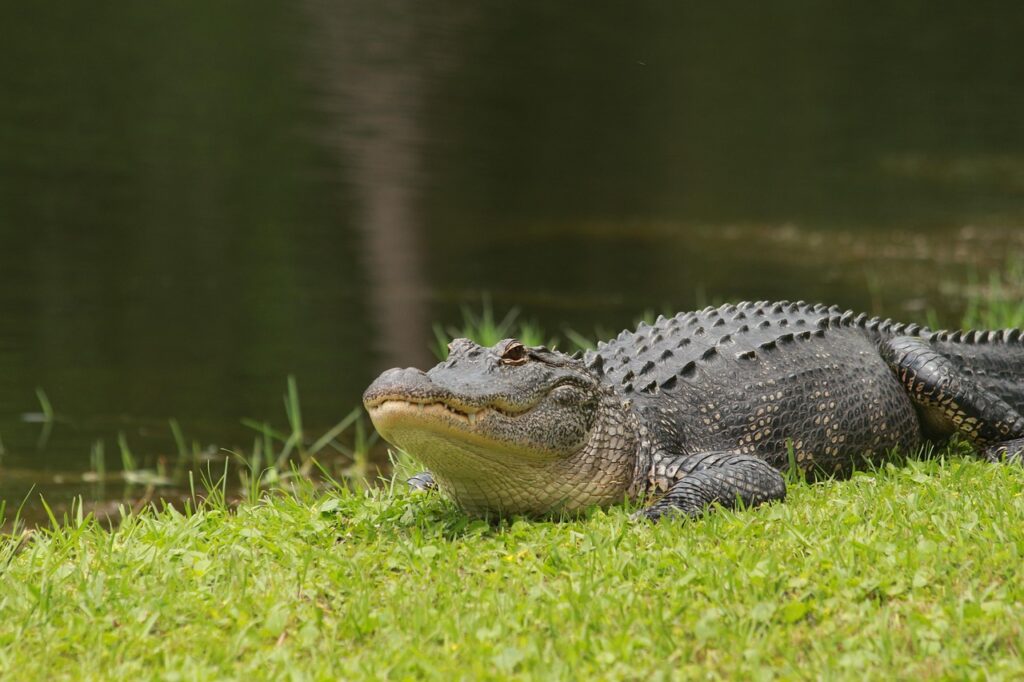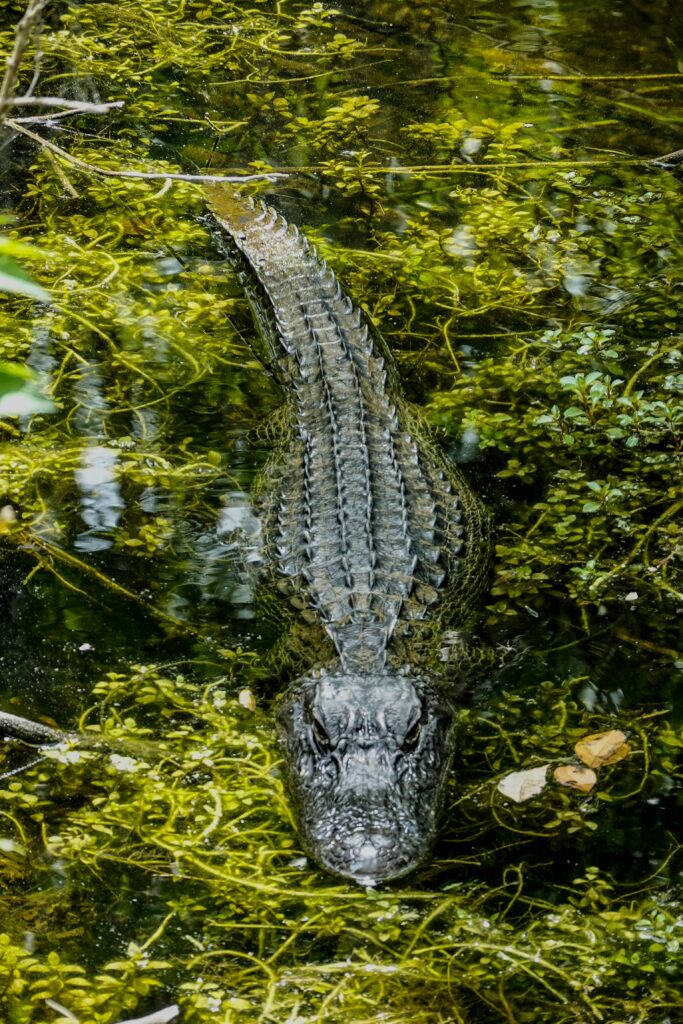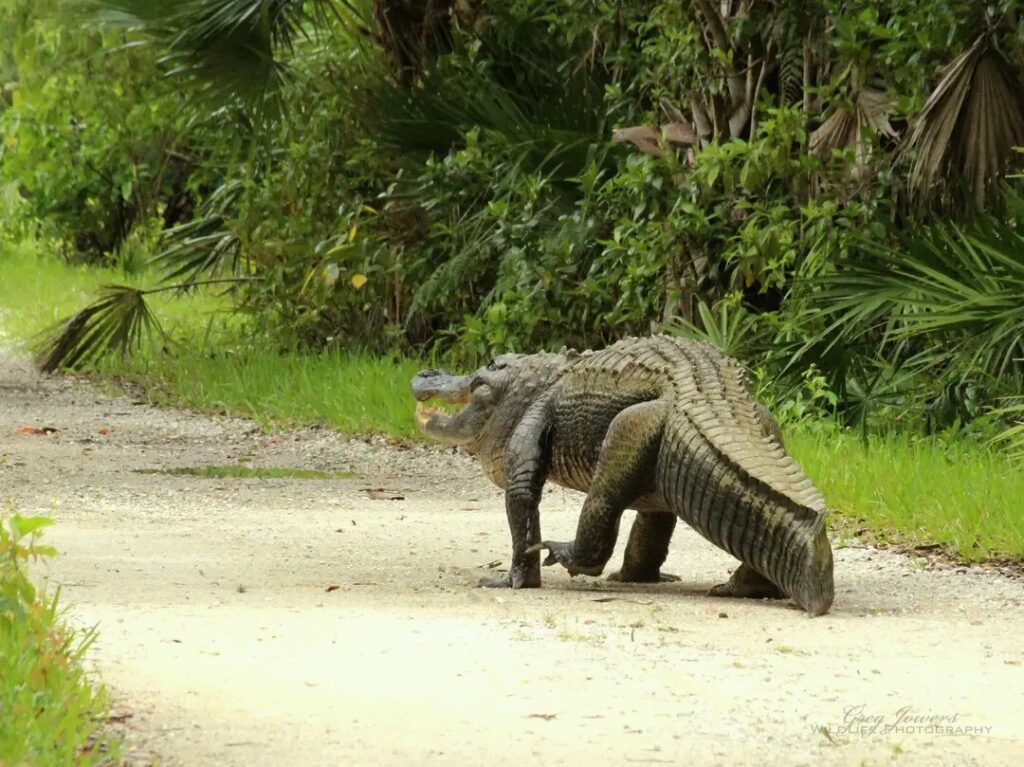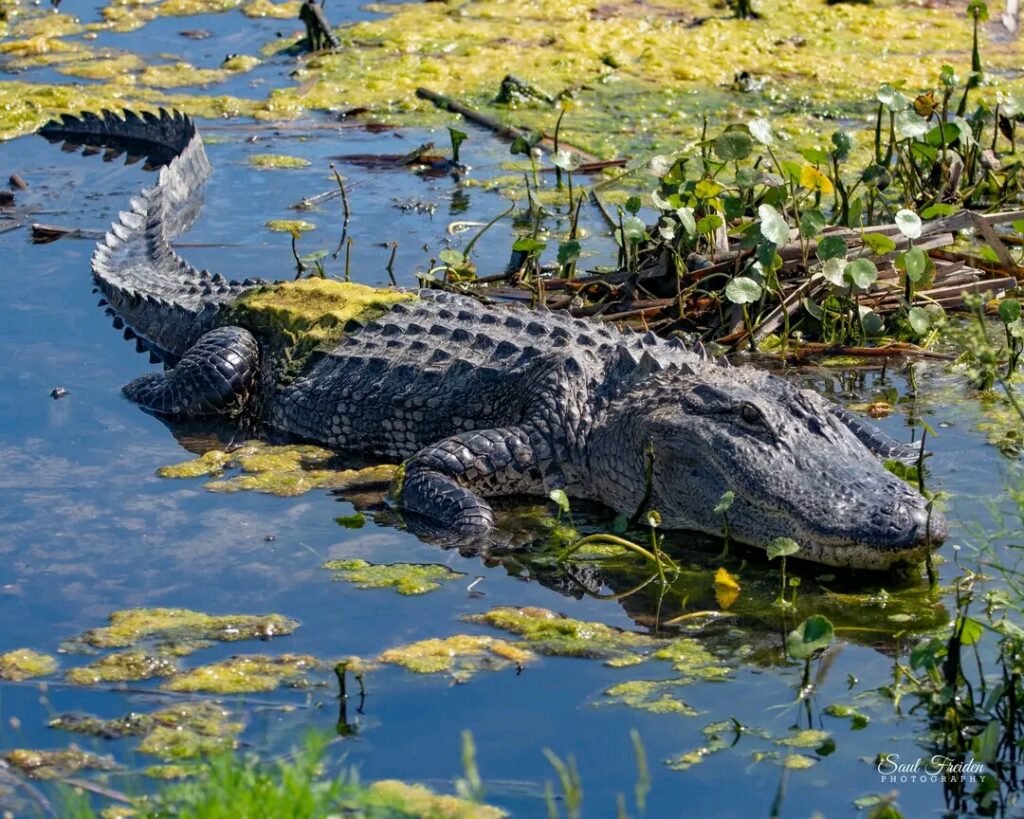Florida is home to the ancient American alligator, a fascinating reptile that has existed for millions of years. These powerful creatures are vital to the balance of Florida’s wetlands. They inhabit swamps, rivers, lakes, and marshes. Both feared and respected, alligators are a key part of the state’s rich wildlife.
Habitat and distribution
Florida alligators live mainly in the southeastern United States, with the largest numbers in Florida and Lauisiana. They prefer freshwater habitats like swamps, marshes, lakes, ponds, rivers, and wetlands. Though they can tolerate brackish water, they avoid saltwater, where crocodiles dominate. One of the best places to see alligators in Florida is Everglades National Park. This massive wetland, known as the ‘River of Grass’, is full of slow moving water, thick vegetation, and plenty of prey perfect for alligators. Other major alligator habitats include Lake Okeechobee, the St, Johns River, Big Cypress National Preserve, and many state parks and wildlife reserves.
Alligators are territorial and choose habitats based on water levels, temperature, and food supply. In dry seasons, they dig ‘gator holes’, which hold water and attract other animals. These holes help many species survive during droughts. Due to habitat loss and human expansion, alligators are now found in urban and suburban areas. They sometimes live in canals, golf course ponds, and even backyard lakes. This increases human alligator encounters, requiring close monitoring by wildlife officials. Their goal is to protect both people and these ancient reptiles, ensuring alligators remain a vital part of Florida’s ecosystem.

Physical characteristics
Florida alligators are large, powerful reptiles with unique features that make them skilled hunters. Adult males grow between 10 to 15 feet long and can weight up to 1,000 pounds. Females are smaller, usually reaching 8 to 10 feet weighing 200 -300 pounds. Their bodies are covered in tough, dark scales with bony plates called osteoderms, which act as natural armor. This helps protect them from predators and fights with other alligators. Unlike crocodiles, they have broad, rounded snouts, which are perfect for crushing prey like turtles. Their eyes, ears, and nostrils are on top of their heads, allowing them to stay mostly underwater while keeping watch on their surroundings.

Since they are cold blooded, alligators rely on the sun to stay warm. In cooler months, they bask in the sun, while in summer, they stay in water or shade to avoid overheating. During winter, they enter brumation, a state where they become inactive but do not fully hibernate. One of their most impressive traits is their bite force, which can exceed 2,000 pounds per square inch. Their powerful jaws have around 80 teeth, which continuously regrow throughout their lives. This allows them to catch and eat a variety of prey, making them one of Florida’s most efficient predators.
Behavior and diet
Florida alligators are opportunistic carnivores, meaning they eat whatever is available in their habitat. Their diet depends on their size, age, and location. Young alligators mainly eat insects, small fish, frogs, and crustaceans. As they grow, they hunt large prey, including fish, turtles, birds, snakes, and even mammals like raccoons and deer. Alligators are ambush predators. They use patience and stealth to catch prey. Often, they stay in the water with only their eyes and nostrils showing, waiting for the right moment to strike. When prey comes close, they attack quickly, using their strong jaws to grab and crush it. If the prey is large, they use a spinning move called the ‘death roll’ to tear it apart.
Although alligators seem dangerous, they usually avoid human unless provoked. Problems arise when people feed them, making them associate humans with food. Because of this risk, feeding alligators is illegal in Florida. Alligators also have complex social behaviors, especially during breeding season, which lasts from April to June. Males make deep, rumbling sounds to attract females and defend their territory. After mating, females build nest mounds using vegetation, mud, and sticks. They lay 20 – 50 eggs inside. The nest’s temperature determines the hatchlings’ sex warmer nests produce males, while cooler nests produce females. Mother alligators fiercely protect their eggs, which take 60 -70 days to hatch. Once they hatch, the mother gently carries the babies to the water in her mouth. She watches over them for up to a year, keeping them safe from predators like birds, raccoons, and even larger alligators.

Conservation and human interaction
Florida alligators were once close to extinction due to overhunting and habitat loss. In the mid-1900s, they were hunted for their valuable leather and meat. Their numbers dropped dangerously low. However, strict conservation efforts helped their population recover, and in 1987, they were removed from the Endangered Species List. Today, Florida alligators have a stable population of over a million. They are classified as a species of least concern and are protected by state and federal laws. Regulated hunting is allowed in some areas to control their numbers and prevent conflicts with humans. The Florida Fish and Wildlife Conservation Commission monitors alligator populations and manages human wildlife interactions. Despite their recovery, alligators still face threats. Habitat destruction, pollution, and illegal hunting put pressure on their survival. As cities expand, alligator encounters with humans have become more common. Attacks are rare but do occur, usually when people ignore safety rules. Experts advise residents and tourists to stay away from the water’s edge, never feed alligators, and be cautions when swimming in freshwater areas.

Alligators are important to Florida’s ecosystem. As top predators, they help control prey populations and keep wetlands balanced. Their gator holes provide water for other animals during dry seasons, making them essential to the environment. Educational programs and wildlife parks, such as Gatorland in Orlando and Everglades Alligator Farm, teach people about these reptiles. These efforts help spread awareness about conservation and the importance of respecting alligators in their natural habitat. Florida alligators are a symbol of the state’s wild beauty and diverse wildlife. They have lived for millions of years, adapting to changes while remaining a key part of Florida’s wetlands. Through often feared, they are intelligent creatures with important roles in nature. Conservation efforts and public awareness help them thrive. Today, alligators coexist with humans while keeping the balance of their natural habitat.
